Immunology Case Study: Mycobacterium Tuberculosis Analysis
VerifiedAdded on 2022/08/30
|8
|1955
|19
Case Study
AI Summary
This case study analyzes a 59-year-old factory worker's diagnosis and treatment for Mycobacterium tuberculosis. The student examines the role of CD4+ Th1 cells and IL2 cytokine in infection control. The analysis explores antigen presentation in macrophages and the impact of HIV coinfection. Furthermore, the study delves into the patient's symptoms, including pneumonitis and pancytopenia, to understand the underlying immune compromise. The assignment references multiple research papers to support the arguments made regarding the patient's condition and treatment options. The student discusses the immune responses and potential treatments, providing a comprehensive overview of the case. The document provides a detailed analysis of the case study, discussing the patient's symptoms, diagnosis, and treatment, with references to relevant research.
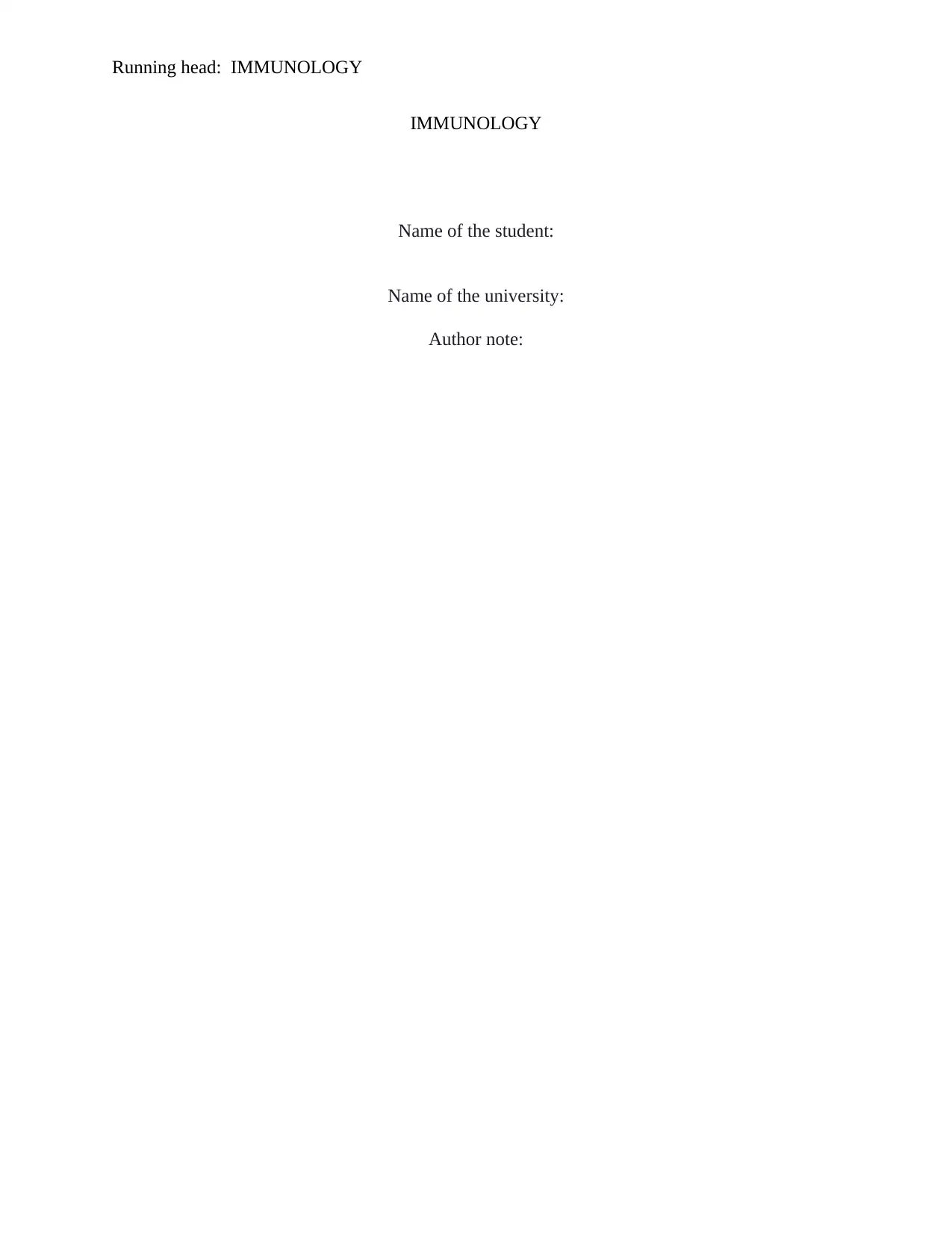
Running head: IMMUNOLOGY
IMMUNOLOGY
Name of the student:
Name of the university:
Author note:
IMMUNOLOGY
Name of the student:
Name of the university:
Author note:
Paraphrase This Document
Need a fresh take? Get an instant paraphrase of this document with our AI Paraphraser
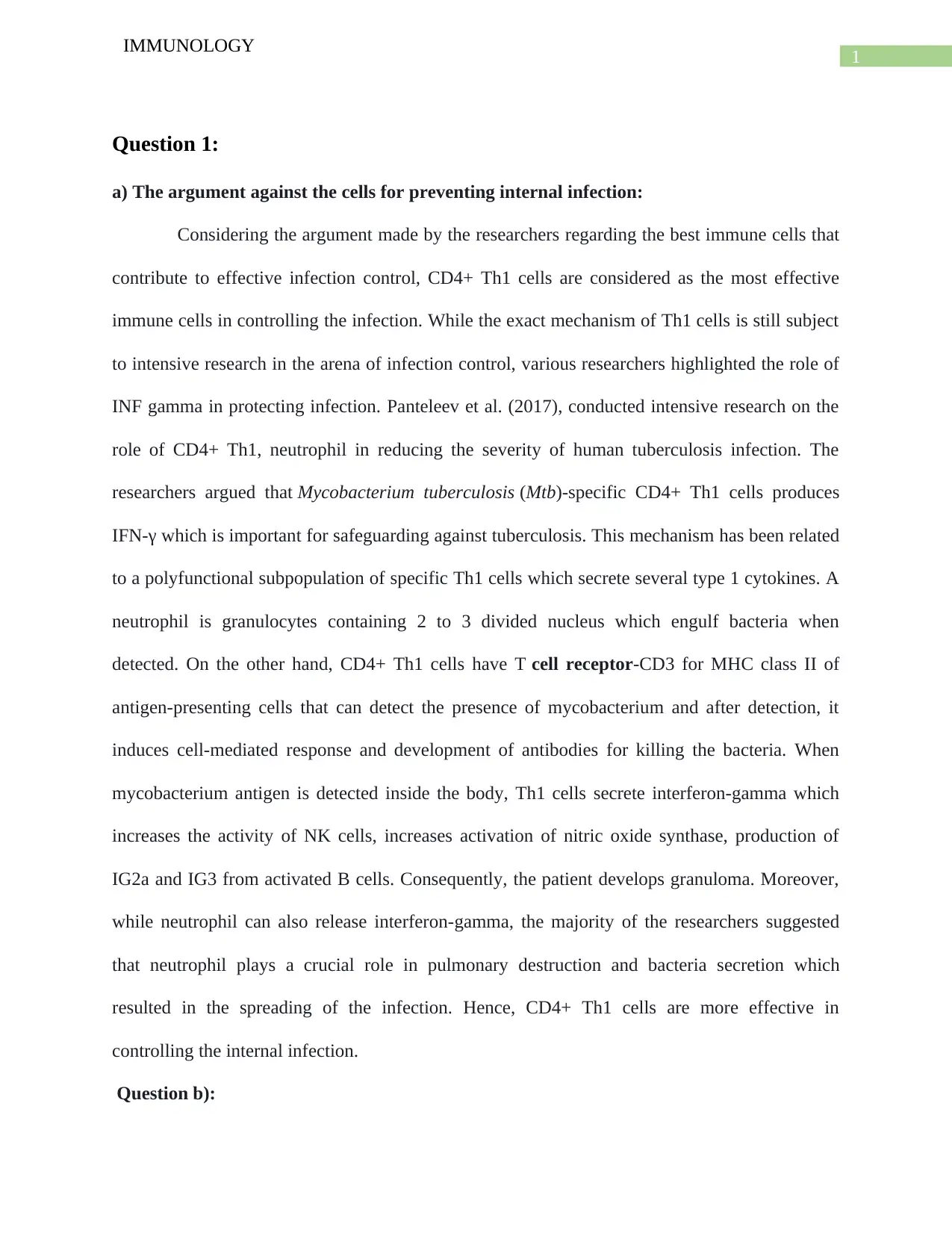
1
IMMUNOLOGY
Question 1:
a) The argument against the cells for preventing internal infection:
Considering the argument made by the researchers regarding the best immune cells that
contribute to effective infection control, CD4+ Th1 cells are considered as the most effective
immune cells in controlling the infection. While the exact mechanism of Th1 cells is still subject
to intensive research in the arena of infection control, various researchers highlighted the role of
INF gamma in protecting infection. Panteleev et al. (2017), conducted intensive research on the
role of CD4+ Th1, neutrophil in reducing the severity of human tuberculosis infection. The
researchers argued that Mycobacterium tuberculosis (Mtb)-specific CD4+ Th1 cells produces
IFN-γ which is important for safeguarding against tuberculosis. This mechanism has been related
to a polyfunctional subpopulation of specific Th1 cells which secrete several type 1 cytokines. A
neutrophil is granulocytes containing 2 to 3 divided nucleus which engulf bacteria when
detected. On the other hand, CD4+ Th1 cells have T cell receptor-CD3 for MHC class II of
antigen-presenting cells that can detect the presence of mycobacterium and after detection, it
induces cell-mediated response and development of antibodies for killing the bacteria. When
mycobacterium antigen is detected inside the body, Th1 cells secrete interferon-gamma which
increases the activity of NK cells, increases activation of nitric oxide synthase, production of
IG2a and IG3 from activated B cells. Consequently, the patient develops granuloma. Moreover,
while neutrophil can also release interferon-gamma, the majority of the researchers suggested
that neutrophil plays a crucial role in pulmonary destruction and bacteria secretion which
resulted in the spreading of the infection. Hence, CD4+ Th1 cells are more effective in
controlling the internal infection.
Question b):
IMMUNOLOGY
Question 1:
a) The argument against the cells for preventing internal infection:
Considering the argument made by the researchers regarding the best immune cells that
contribute to effective infection control, CD4+ Th1 cells are considered as the most effective
immune cells in controlling the infection. While the exact mechanism of Th1 cells is still subject
to intensive research in the arena of infection control, various researchers highlighted the role of
INF gamma in protecting infection. Panteleev et al. (2017), conducted intensive research on the
role of CD4+ Th1, neutrophil in reducing the severity of human tuberculosis infection. The
researchers argued that Mycobacterium tuberculosis (Mtb)-specific CD4+ Th1 cells produces
IFN-γ which is important for safeguarding against tuberculosis. This mechanism has been related
to a polyfunctional subpopulation of specific Th1 cells which secrete several type 1 cytokines. A
neutrophil is granulocytes containing 2 to 3 divided nucleus which engulf bacteria when
detected. On the other hand, CD4+ Th1 cells have T cell receptor-CD3 for MHC class II of
antigen-presenting cells that can detect the presence of mycobacterium and after detection, it
induces cell-mediated response and development of antibodies for killing the bacteria. When
mycobacterium antigen is detected inside the body, Th1 cells secrete interferon-gamma which
increases the activity of NK cells, increases activation of nitric oxide synthase, production of
IG2a and IG3 from activated B cells. Consequently, the patient develops granuloma. Moreover,
while neutrophil can also release interferon-gamma, the majority of the researchers suggested
that neutrophil plays a crucial role in pulmonary destruction and bacteria secretion which
resulted in the spreading of the infection. Hence, CD4+ Th1 cells are more effective in
controlling the internal infection.
Question b):
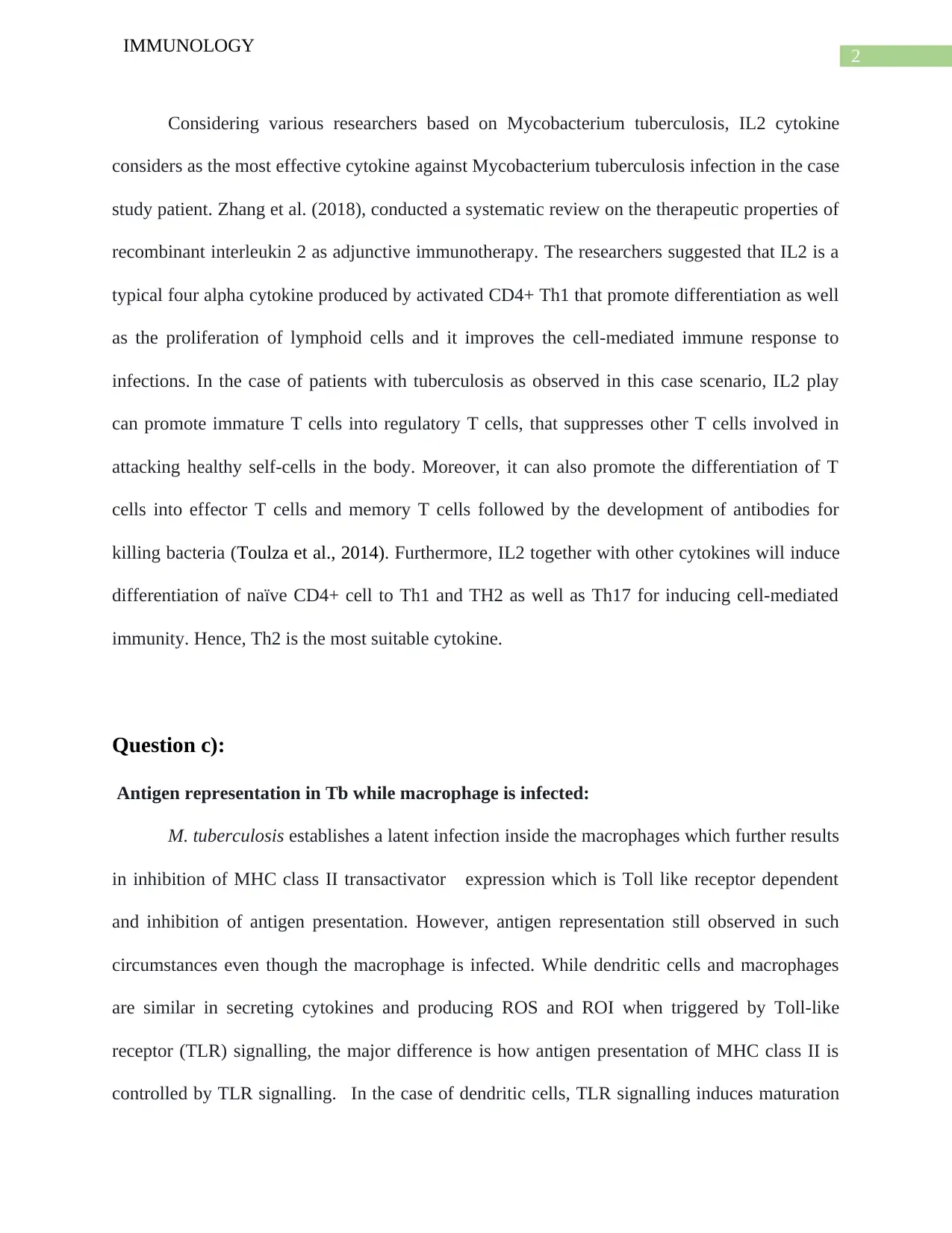
2
IMMUNOLOGY
Considering various researchers based on Mycobacterium tuberculosis, IL2 cytokine
considers as the most effective cytokine against Mycobacterium tuberculosis infection in the case
study patient. Zhang et al. (2018), conducted a systematic review on the therapeutic properties of
recombinant interleukin 2 as adjunctive immunotherapy. The researchers suggested that IL2 is a
typical four alpha cytokine produced by activated CD4+ Th1 that promote differentiation as well
as the proliferation of lymphoid cells and it improves the cell-mediated immune response to
infections. In the case of patients with tuberculosis as observed in this case scenario, IL2 play
can promote immature T cells into regulatory T cells, that suppresses other T cells involved in
attacking healthy self-cells in the body. Moreover, it can also promote the differentiation of T
cells into effector T cells and memory T cells followed by the development of antibodies for
killing bacteria (Toulza et al., 2014). Furthermore, IL2 together with other cytokines will induce
differentiation of naïve CD4+ cell to Th1 and TH2 as well as Th17 for inducing cell-mediated
immunity. Hence, Th2 is the most suitable cytokine.
Question c):
Antigen representation in Tb while macrophage is infected:
M. tuberculosis establishes a latent infection inside the macrophages which further results
in inhibition of MHC class II transactivator expression which is Toll like receptor dependent
and inhibition of antigen presentation. However, antigen representation still observed in such
circumstances even though the macrophage is infected. While dendritic cells and macrophages
are similar in secreting cytokines and producing ROS and ROI when triggered by Toll-like
receptor (TLR) signalling, the major difference is how antigen presentation of MHC class II is
controlled by TLR signalling. In the case of dendritic cells, TLR signalling induces maturation
IMMUNOLOGY
Considering various researchers based on Mycobacterium tuberculosis, IL2 cytokine
considers as the most effective cytokine against Mycobacterium tuberculosis infection in the case
study patient. Zhang et al. (2018), conducted a systematic review on the therapeutic properties of
recombinant interleukin 2 as adjunctive immunotherapy. The researchers suggested that IL2 is a
typical four alpha cytokine produced by activated CD4+ Th1 that promote differentiation as well
as the proliferation of lymphoid cells and it improves the cell-mediated immune response to
infections. In the case of patients with tuberculosis as observed in this case scenario, IL2 play
can promote immature T cells into regulatory T cells, that suppresses other T cells involved in
attacking healthy self-cells in the body. Moreover, it can also promote the differentiation of T
cells into effector T cells and memory T cells followed by the development of antibodies for
killing bacteria (Toulza et al., 2014). Furthermore, IL2 together with other cytokines will induce
differentiation of naïve CD4+ cell to Th1 and TH2 as well as Th17 for inducing cell-mediated
immunity. Hence, Th2 is the most suitable cytokine.
Question c):
Antigen representation in Tb while macrophage is infected:
M. tuberculosis establishes a latent infection inside the macrophages which further results
in inhibition of MHC class II transactivator expression which is Toll like receptor dependent
and inhibition of antigen presentation. However, antigen representation still observed in such
circumstances even though the macrophage is infected. While dendritic cells and macrophages
are similar in secreting cytokines and producing ROS and ROI when triggered by Toll-like
receptor (TLR) signalling, the major difference is how antigen presentation of MHC class II is
controlled by TLR signalling. In the case of dendritic cells, TLR signalling induces maturation
⊘ This is a preview!⊘
Do you want full access?
Subscribe today to unlock all pages.

Trusted by 1+ million students worldwide
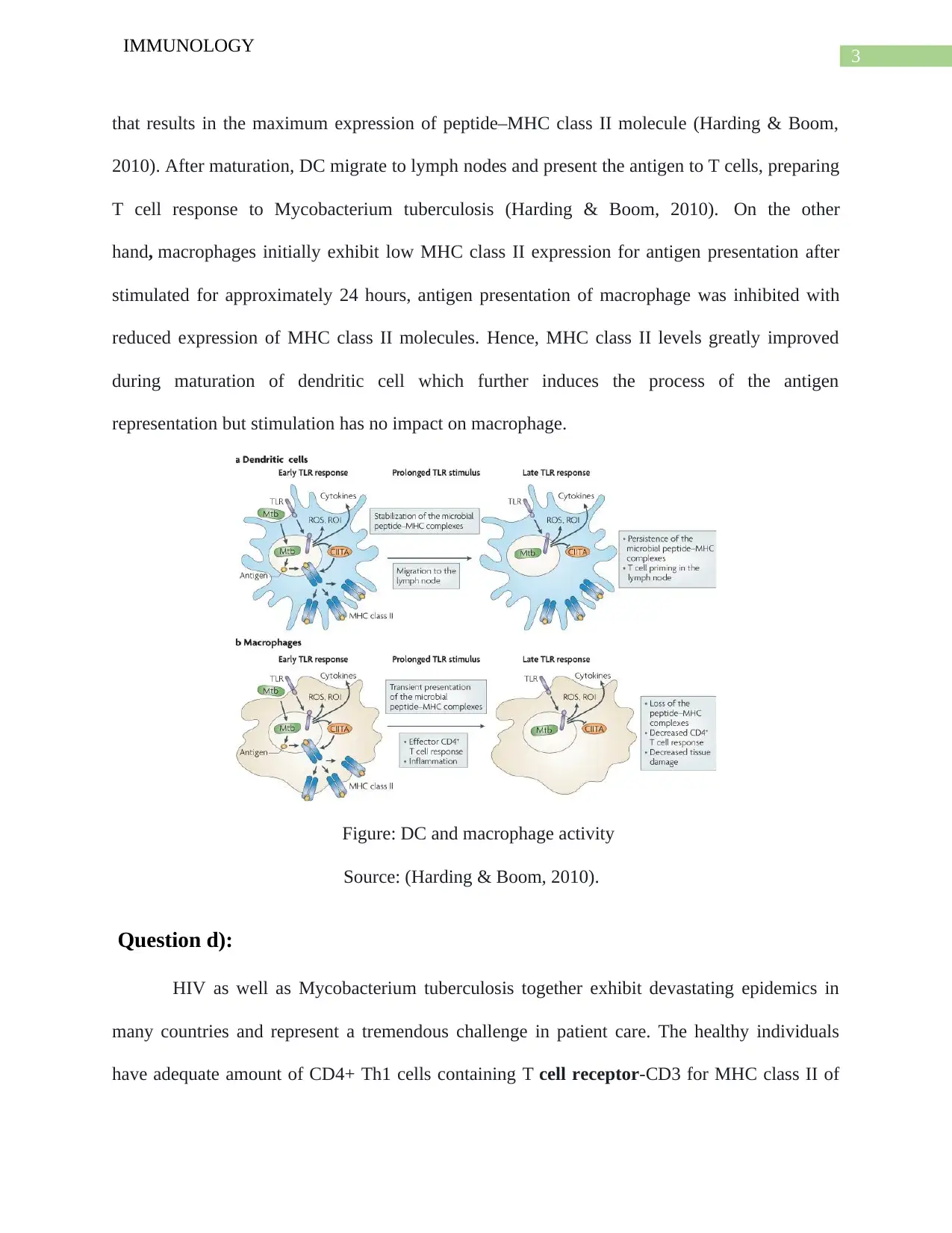
3
IMMUNOLOGY
that results in the maximum expression of peptide–MHC class II molecule (Harding & Boom,
2010). After maturation, DC migrate to lymph nodes and present the antigen to T cells, preparing
T cell response to Mycobacterium tuberculosis (Harding & Boom, 2010). On the other
hand, macrophages initially exhibit low MHC class II expression for antigen presentation after
stimulated for approximately 24 hours, antigen presentation of macrophage was inhibited with
reduced expression of MHC class II molecules. Hence, MHC class II levels greatly improved
during maturation of dendritic cell which further induces the process of the antigen
representation but stimulation has no impact on macrophage.
Figure: DC and macrophage activity
Source: (Harding & Boom, 2010).
Question d):
HIV as well as Mycobacterium tuberculosis together exhibit devastating epidemics in
many countries and represent a tremendous challenge in patient care. The healthy individuals
have adequate amount of CD4+ Th1 cells containing T cell receptor-CD3 for MHC class II of
IMMUNOLOGY
that results in the maximum expression of peptide–MHC class II molecule (Harding & Boom,
2010). After maturation, DC migrate to lymph nodes and present the antigen to T cells, preparing
T cell response to Mycobacterium tuberculosis (Harding & Boom, 2010). On the other
hand, macrophages initially exhibit low MHC class II expression for antigen presentation after
stimulated for approximately 24 hours, antigen presentation of macrophage was inhibited with
reduced expression of MHC class II molecules. Hence, MHC class II levels greatly improved
during maturation of dendritic cell which further induces the process of the antigen
representation but stimulation has no impact on macrophage.
Figure: DC and macrophage activity
Source: (Harding & Boom, 2010).
Question d):
HIV as well as Mycobacterium tuberculosis together exhibit devastating epidemics in
many countries and represent a tremendous challenge in patient care. The healthy individuals
have adequate amount of CD4+ Th1 cells containing T cell receptor-CD3 for MHC class II of
Paraphrase This Document
Need a fresh take? Get an instant paraphrase of this document with our AI Paraphraser
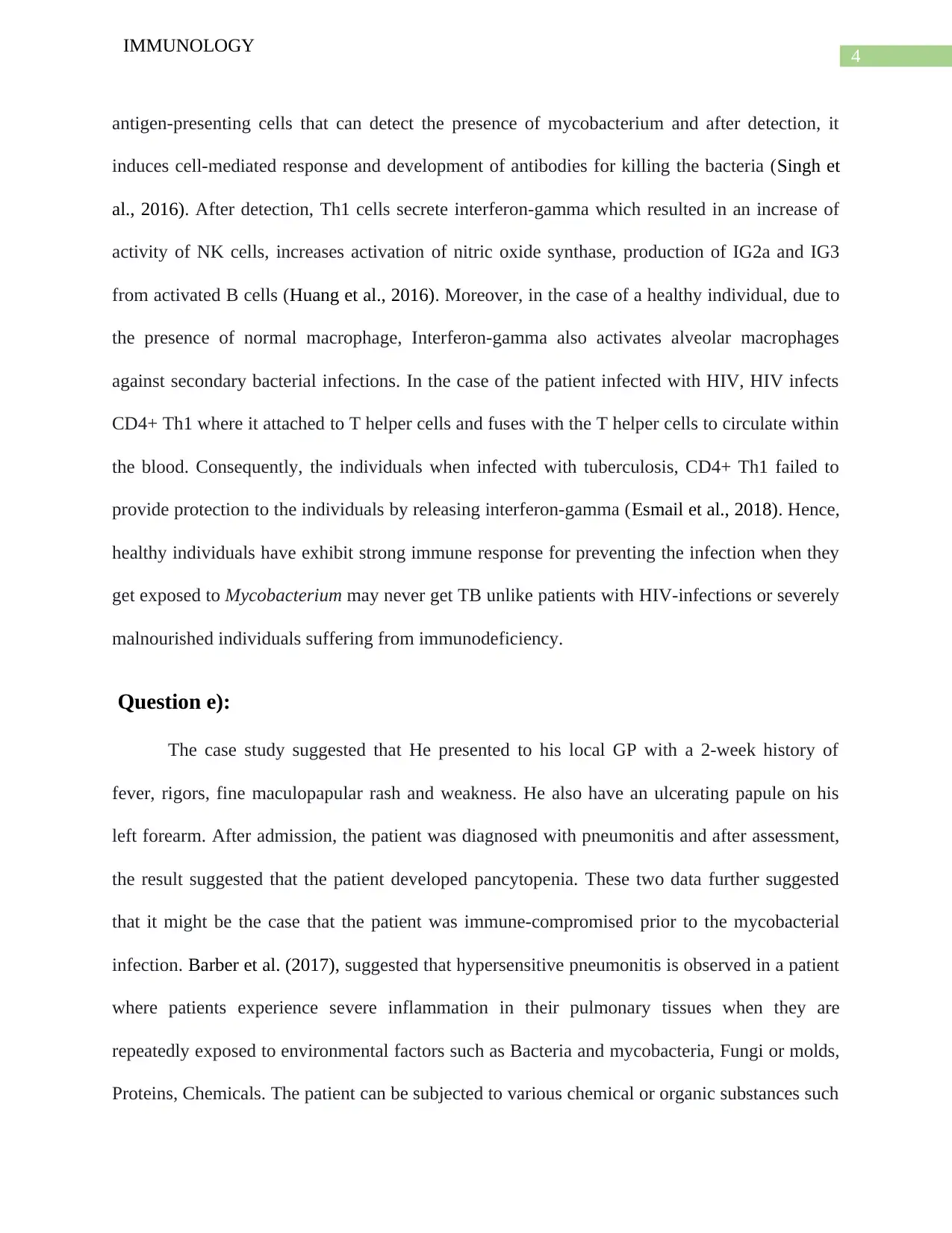
4
IMMUNOLOGY
antigen-presenting cells that can detect the presence of mycobacterium and after detection, it
induces cell-mediated response and development of antibodies for killing the bacteria (Singh et
al., 2016). After detection, Th1 cells secrete interferon-gamma which resulted in an increase of
activity of NK cells, increases activation of nitric oxide synthase, production of IG2a and IG3
from activated B cells (Huang et al., 2016). Moreover, in the case of a healthy individual, due to
the presence of normal macrophage, Interferon-gamma also activates alveolar macrophages
against secondary bacterial infections. In the case of the patient infected with HIV, HIV infects
CD4+ Th1 where it attached to T helper cells and fuses with the T helper cells to circulate within
the blood. Consequently, the individuals when infected with tuberculosis, CD4+ Th1 failed to
provide protection to the individuals by releasing interferon-gamma (Esmail et al., 2018). Hence,
healthy individuals have exhibit strong immune response for preventing the infection when they
get exposed to Mycobacterium may never get TB unlike patients with HIV-infections or severely
malnourished individuals suffering from immunodeficiency.
Question e):
The case study suggested that He presented to his local GP with a 2-week history of
fever, rigors, fine maculopapular rash and weakness. He also have an ulcerating papule on his
left forearm. After admission, the patient was diagnosed with pneumonitis and after assessment,
the result suggested that the patient developed pancytopenia. These two data further suggested
that it might be the case that the patient was immune-compromised prior to the mycobacterial
infection. Barber et al. (2017), suggested that hypersensitive pneumonitis is observed in a patient
where patients experience severe inflammation in their pulmonary tissues when they are
repeatedly exposed to environmental factors such as Bacteria and mycobacteria, Fungi or molds,
Proteins, Chemicals. The patient can be subjected to various chemical or organic substances such
IMMUNOLOGY
antigen-presenting cells that can detect the presence of mycobacterium and after detection, it
induces cell-mediated response and development of antibodies for killing the bacteria (Singh et
al., 2016). After detection, Th1 cells secrete interferon-gamma which resulted in an increase of
activity of NK cells, increases activation of nitric oxide synthase, production of IG2a and IG3
from activated B cells (Huang et al., 2016). Moreover, in the case of a healthy individual, due to
the presence of normal macrophage, Interferon-gamma also activates alveolar macrophages
against secondary bacterial infections. In the case of the patient infected with HIV, HIV infects
CD4+ Th1 where it attached to T helper cells and fuses with the T helper cells to circulate within
the blood. Consequently, the individuals when infected with tuberculosis, CD4+ Th1 failed to
provide protection to the individuals by releasing interferon-gamma (Esmail et al., 2018). Hence,
healthy individuals have exhibit strong immune response for preventing the infection when they
get exposed to Mycobacterium may never get TB unlike patients with HIV-infections or severely
malnourished individuals suffering from immunodeficiency.
Question e):
The case study suggested that He presented to his local GP with a 2-week history of
fever, rigors, fine maculopapular rash and weakness. He also have an ulcerating papule on his
left forearm. After admission, the patient was diagnosed with pneumonitis and after assessment,
the result suggested that the patient developed pancytopenia. These two data further suggested
that it might be the case that the patient was immune-compromised prior to the mycobacterial
infection. Barber et al. (2017), suggested that hypersensitive pneumonitis is observed in a patient
where patients experience severe inflammation in their pulmonary tissues when they are
repeatedly exposed to environmental factors such as Bacteria and mycobacteria, Fungi or molds,
Proteins, Chemicals. The patient can be subjected to various chemical or organic substances such
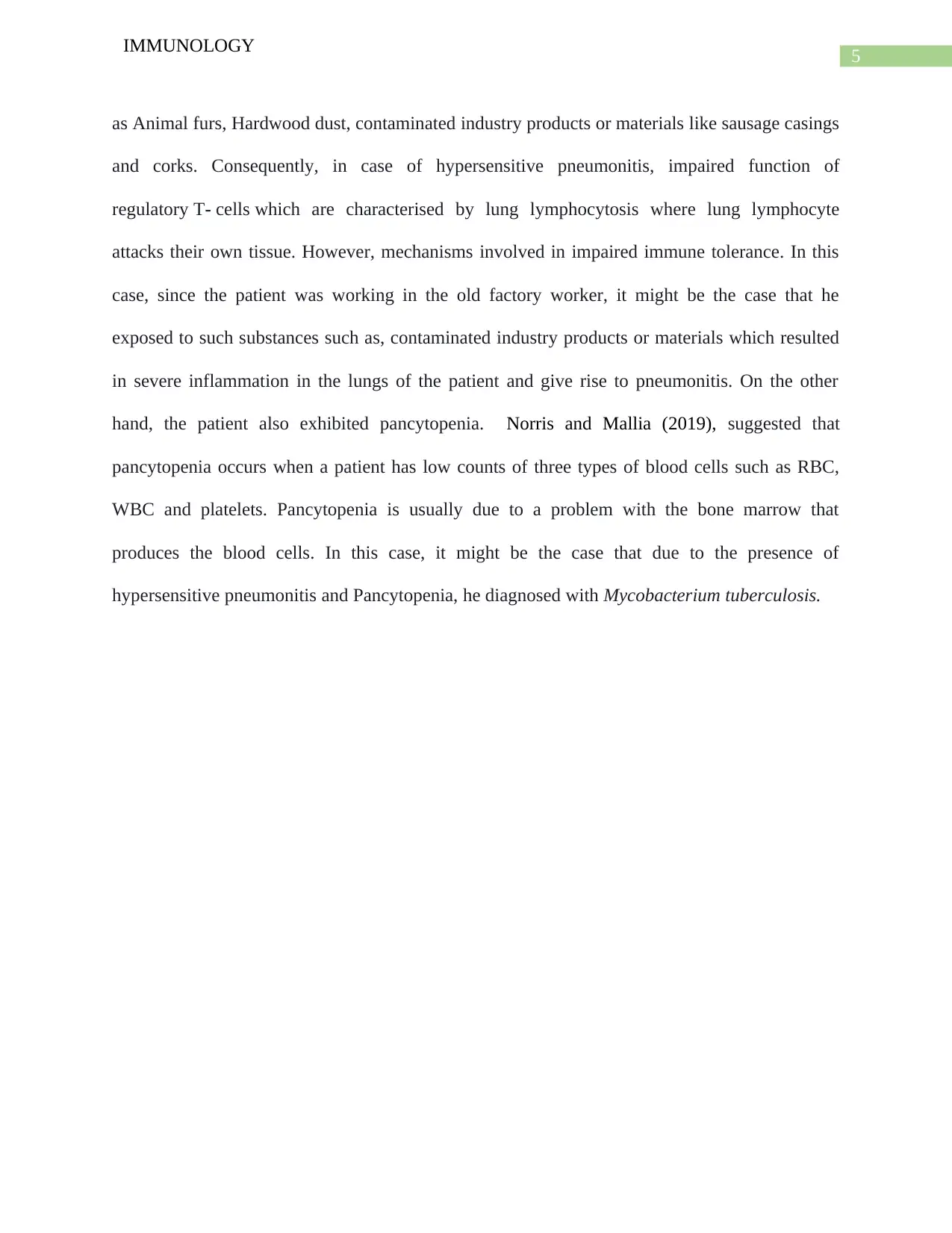
5
IMMUNOLOGY
as Animal furs, Hardwood dust, contaminated industry products or materials like sausage casings
and corks. Consequently, in case of hypersensitive pneumonitis, impaired function of
regulatory T- cells which are characterised by lung lymphocytosis where lung lymphocyte
attacks their own tissue. However, mechanisms involved in impaired immune tolerance. In this
case, since the patient was working in the old factory worker, it might be the case that he
exposed to such substances such as, contaminated industry products or materials which resulted
in severe inflammation in the lungs of the patient and give rise to pneumonitis. On the other
hand, the patient also exhibited pancytopenia. Norris and Mallia (2019), suggested that
pancytopenia occurs when a patient has low counts of three types of blood cells such as RBC,
WBC and platelets. Pancytopenia is usually due to a problem with the bone marrow that
produces the blood cells. In this case, it might be the case that due to the presence of
hypersensitive pneumonitis and Pancytopenia, he diagnosed with Mycobacterium tuberculosis.
IMMUNOLOGY
as Animal furs, Hardwood dust, contaminated industry products or materials like sausage casings
and corks. Consequently, in case of hypersensitive pneumonitis, impaired function of
regulatory T- cells which are characterised by lung lymphocytosis where lung lymphocyte
attacks their own tissue. However, mechanisms involved in impaired immune tolerance. In this
case, since the patient was working in the old factory worker, it might be the case that he
exposed to such substances such as, contaminated industry products or materials which resulted
in severe inflammation in the lungs of the patient and give rise to pneumonitis. On the other
hand, the patient also exhibited pancytopenia. Norris and Mallia (2019), suggested that
pancytopenia occurs when a patient has low counts of three types of blood cells such as RBC,
WBC and platelets. Pancytopenia is usually due to a problem with the bone marrow that
produces the blood cells. In this case, it might be the case that due to the presence of
hypersensitive pneumonitis and Pancytopenia, he diagnosed with Mycobacterium tuberculosis.
⊘ This is a preview!⊘
Do you want full access?
Subscribe today to unlock all pages.

Trusted by 1+ million students worldwide
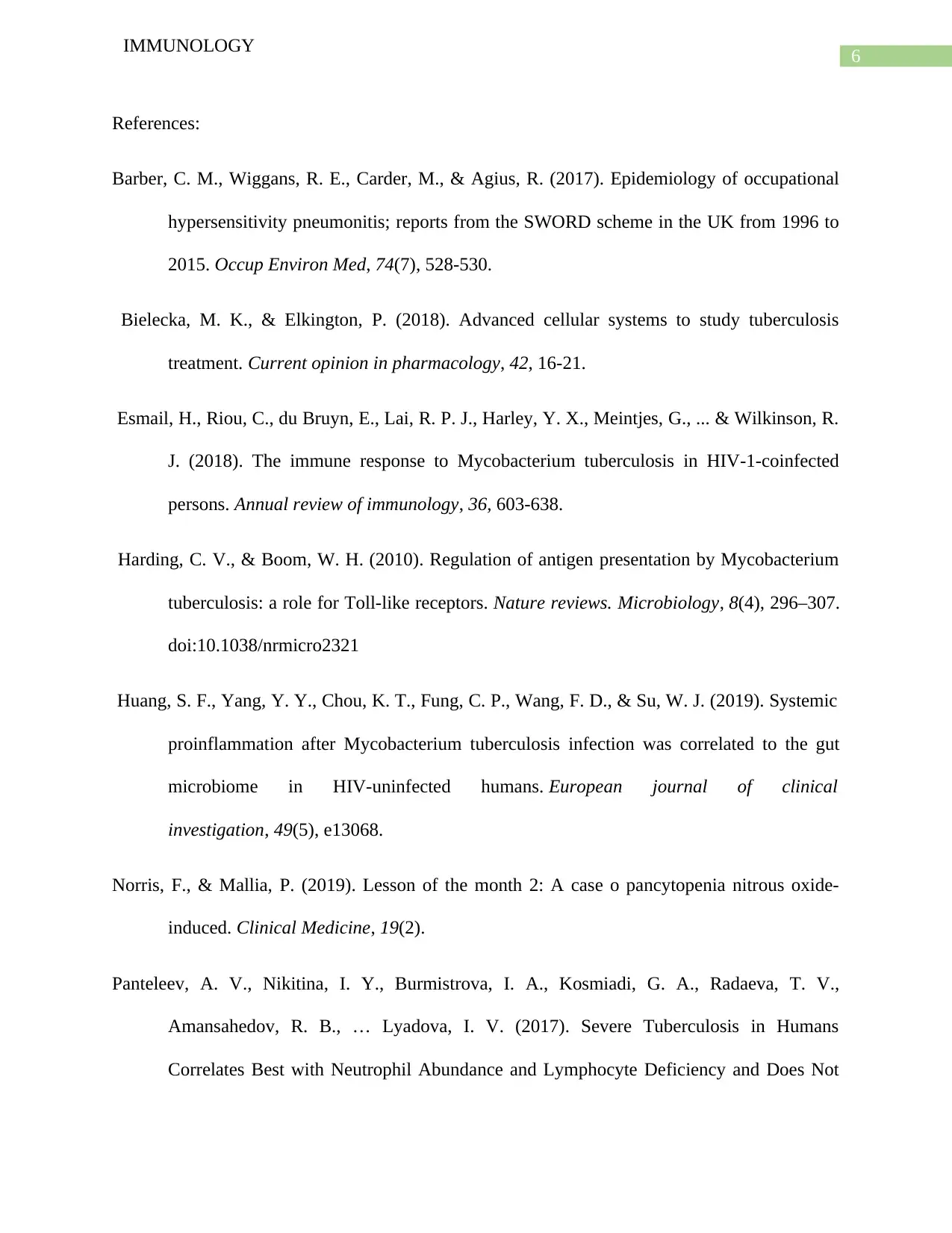
6
IMMUNOLOGY
References:
Barber, C. M., Wiggans, R. E., Carder, M., & Agius, R. (2017). Epidemiology of occupational
hypersensitivity pneumonitis; reports from the SWORD scheme in the UK from 1996 to
2015. Occup Environ Med, 74(7), 528-530.
Bielecka, M. K., & Elkington, P. (2018). Advanced cellular systems to study tuberculosis
treatment. Current opinion in pharmacology, 42, 16-21.
Esmail, H., Riou, C., du Bruyn, E., Lai, R. P. J., Harley, Y. X., Meintjes, G., ... & Wilkinson, R.
J. (2018). The immune response to Mycobacterium tuberculosis in HIV-1-coinfected
persons. Annual review of immunology, 36, 603-638.
Harding, C. V., & Boom, W. H. (2010). Regulation of antigen presentation by Mycobacterium
tuberculosis: a role for Toll-like receptors. Nature reviews. Microbiology, 8(4), 296–307.
doi:10.1038/nrmicro2321
Huang, S. F., Yang, Y. Y., Chou, K. T., Fung, C. P., Wang, F. D., & Su, W. J. (2019). Systemic
proinflammation after Mycobacterium tuberculosis infection was correlated to the gut
microbiome in HIV‐uninfected humans. European journal of clinical
investigation, 49(5), e13068.
Norris, F., & Mallia, P. (2019). Lesson of the month 2: A case o pancytopenia nitrous oxide-
induced. Clinical Medicine, 19(2).
Panteleev, A. V., Nikitina, I. Y., Burmistrova, I. A., Kosmiadi, G. A., Radaeva, T. V.,
Amansahedov, R. B., … Lyadova, I. V. (2017). Severe Tuberculosis in Humans
Correlates Best with Neutrophil Abundance and Lymphocyte Deficiency and Does Not
IMMUNOLOGY
References:
Barber, C. M., Wiggans, R. E., Carder, M., & Agius, R. (2017). Epidemiology of occupational
hypersensitivity pneumonitis; reports from the SWORD scheme in the UK from 1996 to
2015. Occup Environ Med, 74(7), 528-530.
Bielecka, M. K., & Elkington, P. (2018). Advanced cellular systems to study tuberculosis
treatment. Current opinion in pharmacology, 42, 16-21.
Esmail, H., Riou, C., du Bruyn, E., Lai, R. P. J., Harley, Y. X., Meintjes, G., ... & Wilkinson, R.
J. (2018). The immune response to Mycobacterium tuberculosis in HIV-1-coinfected
persons. Annual review of immunology, 36, 603-638.
Harding, C. V., & Boom, W. H. (2010). Regulation of antigen presentation by Mycobacterium
tuberculosis: a role for Toll-like receptors. Nature reviews. Microbiology, 8(4), 296–307.
doi:10.1038/nrmicro2321
Huang, S. F., Yang, Y. Y., Chou, K. T., Fung, C. P., Wang, F. D., & Su, W. J. (2019). Systemic
proinflammation after Mycobacterium tuberculosis infection was correlated to the gut
microbiome in HIV‐uninfected humans. European journal of clinical
investigation, 49(5), e13068.
Norris, F., & Mallia, P. (2019). Lesson of the month 2: A case o pancytopenia nitrous oxide-
induced. Clinical Medicine, 19(2).
Panteleev, A. V., Nikitina, I. Y., Burmistrova, I. A., Kosmiadi, G. A., Radaeva, T. V.,
Amansahedov, R. B., … Lyadova, I. V. (2017). Severe Tuberculosis in Humans
Correlates Best with Neutrophil Abundance and Lymphocyte Deficiency and Does Not
Paraphrase This Document
Need a fresh take? Get an instant paraphrase of this document with our AI Paraphraser
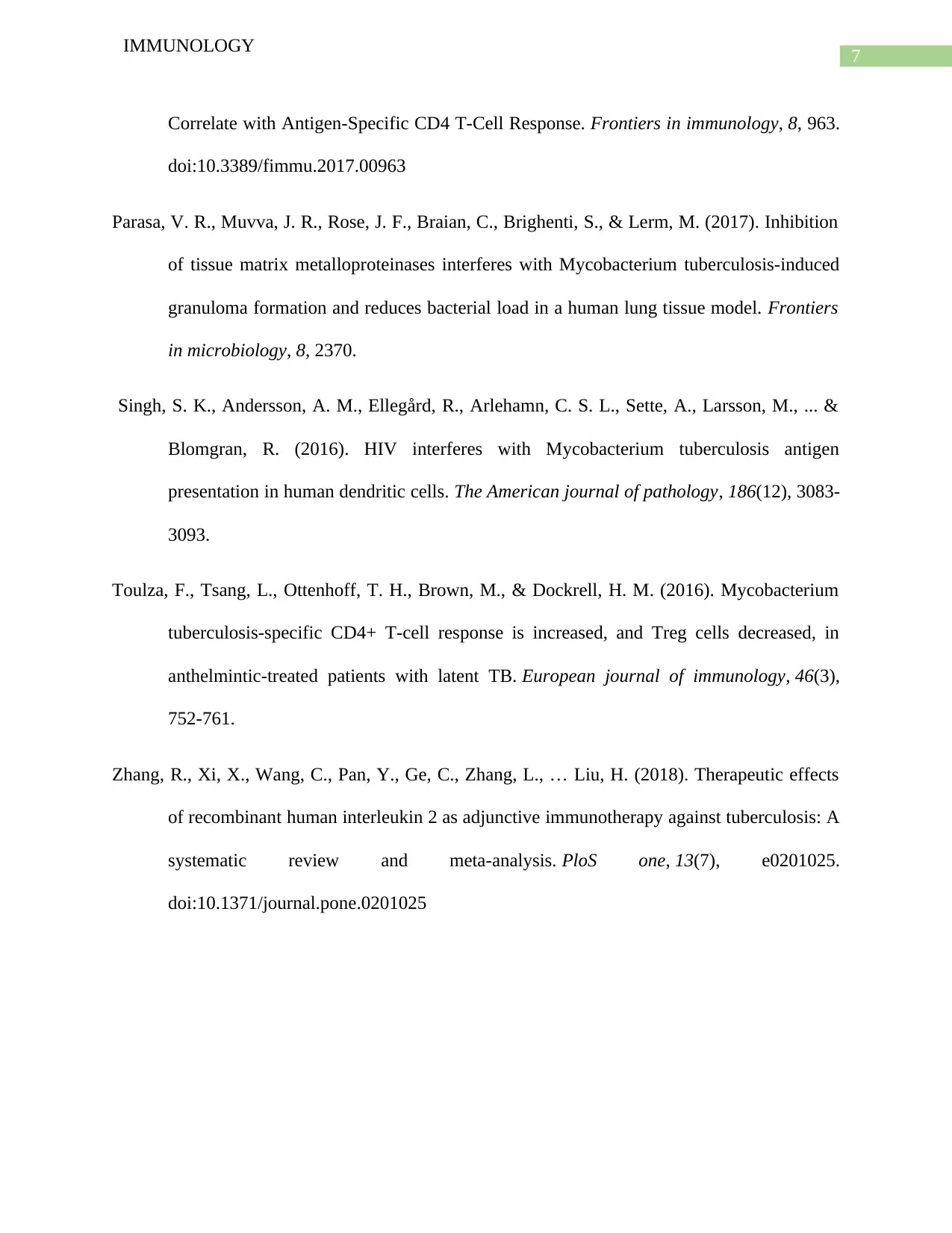
7
IMMUNOLOGY
Correlate with Antigen-Specific CD4 T-Cell Response. Frontiers in immunology, 8, 963.
doi:10.3389/fimmu.2017.00963
Parasa, V. R., Muvva, J. R., Rose, J. F., Braian, C., Brighenti, S., & Lerm, M. (2017). Inhibition
of tissue matrix metalloproteinases interferes with Mycobacterium tuberculosis-induced
granuloma formation and reduces bacterial load in a human lung tissue model. Frontiers
in microbiology, 8, 2370.
Singh, S. K., Andersson, A. M., Ellegård, R., Arlehamn, C. S. L., Sette, A., Larsson, M., ... &
Blomgran, R. (2016). HIV interferes with Mycobacterium tuberculosis antigen
presentation in human dendritic cells. The American journal of pathology, 186(12), 3083-
3093.
Toulza, F., Tsang, L., Ottenhoff, T. H., Brown, M., & Dockrell, H. M. (2016). Mycobacterium
tuberculosis‐specific CD4+ T‐cell response is increased, and Treg cells decreased, in
anthelmintic‐treated patients with latent TB. European journal of immunology, 46(3),
752-761.
Zhang, R., Xi, X., Wang, C., Pan, Y., Ge, C., Zhang, L., … Liu, H. (2018). Therapeutic effects
of recombinant human interleukin 2 as adjunctive immunotherapy against tuberculosis: A
systematic review and meta-analysis. PloS one, 13(7), e0201025.
doi:10.1371/journal.pone.0201025
IMMUNOLOGY
Correlate with Antigen-Specific CD4 T-Cell Response. Frontiers in immunology, 8, 963.
doi:10.3389/fimmu.2017.00963
Parasa, V. R., Muvva, J. R., Rose, J. F., Braian, C., Brighenti, S., & Lerm, M. (2017). Inhibition
of tissue matrix metalloproteinases interferes with Mycobacterium tuberculosis-induced
granuloma formation and reduces bacterial load in a human lung tissue model. Frontiers
in microbiology, 8, 2370.
Singh, S. K., Andersson, A. M., Ellegård, R., Arlehamn, C. S. L., Sette, A., Larsson, M., ... &
Blomgran, R. (2016). HIV interferes with Mycobacterium tuberculosis antigen
presentation in human dendritic cells. The American journal of pathology, 186(12), 3083-
3093.
Toulza, F., Tsang, L., Ottenhoff, T. H., Brown, M., & Dockrell, H. M. (2016). Mycobacterium
tuberculosis‐specific CD4+ T‐cell response is increased, and Treg cells decreased, in
anthelmintic‐treated patients with latent TB. European journal of immunology, 46(3),
752-761.
Zhang, R., Xi, X., Wang, C., Pan, Y., Ge, C., Zhang, L., … Liu, H. (2018). Therapeutic effects
of recombinant human interleukin 2 as adjunctive immunotherapy against tuberculosis: A
systematic review and meta-analysis. PloS one, 13(7), e0201025.
doi:10.1371/journal.pone.0201025
1 out of 8
Related Documents
Your All-in-One AI-Powered Toolkit for Academic Success.
+13062052269
info@desklib.com
Available 24*7 on WhatsApp / Email
![[object Object]](/_next/static/media/star-bottom.7253800d.svg)
Unlock your academic potential
Copyright © 2020–2025 A2Z Services. All Rights Reserved. Developed and managed by ZUCOL.





